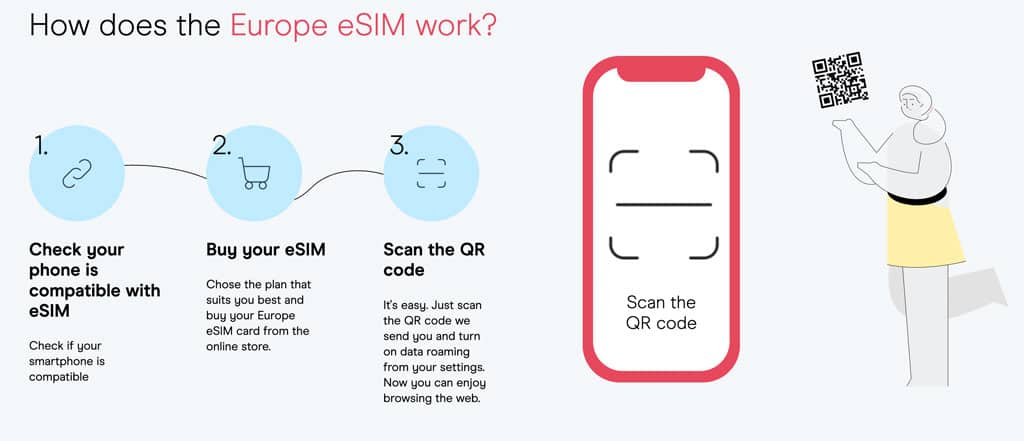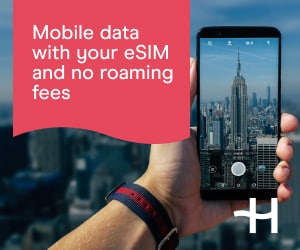Holafly, the eSIM for travelling to Europe and avoiding roaming fees
This website uses affiliate links which may earn a commission at no additional cost to you. As an Amazon Associate I earn from qualifying purchases.
Updated: 3rd June 2022
Produced in partnership with HolaFly
Sadly, the days of travelling with just a beat-up map and our gut instincts are long gone, and while it’s still nice to dabble in some off the beaten path adventures in Europe or further afield, the digital world we live in has undoubtedly changed the way we travel forever.
Don’t get me wrong; there are still times I love to disconnect from everything and leave my phone at home. Whether that’s hiking in Peru or getting lost in the mountains of Tajikistan, there is no denying the sense of freedom is liberating. But then there are times when I want to be connected to the internet, not just to friends and family elsewhere, but also to the technology which can improve my trip. Over the last few years, I’ve really embraced how technology can improve my travels using the phone we all have in our pockets.
Being able to converse with someone in Spanish or German thanks to a language app, for example, or paying a fair price for a taxi in Croatia because I can instantly work out the Kuna conversion rate, are both very helpful things that can improve the travel experience. I even use my phone when travelling to book car-pooling on BlaBlaCar or manage booking reservations on WhatsApp – the bottom line is that having a good internet connection has become somewhat essential when travelling around Europe or anywhere for that matter.
Now, with the changes of Brexit officially kicking in and many phone operators breaking their promise not to reintroduce roaming charges, visitors from the UK (and indeed, outside of the EU) have to consider the best way to stay connected while travelling in Europe without paying more in charges than before, and an eSIM for travel to Europe from Holafly might be the most convenient solution, depending on the length and style of your holiday – due to restrictions on hotspot use. However, it might not be suitable for those working remotely.

How have roaming charges affected travellers from the UK visiting the EU since 2022?
This is a tricky question to answer, as I have seen in recent months some operators who promised not to bring roaming charges back make a U-turn and introduce costs, while some others have kept their promise – albeit with reduced data caps.
Essentially, UK mobile phone operators no longer have to follow the laws regarding roaming charges as legislated by the EU Parliament. As such, operators will set their own charges and rates, and you can usually easily check these on your provider’s website.
However, one good piece of news is that the UK government has made their own laws to at least limit these new roaming costs, if not to ban them altogether. This includes a monthly £45 limit on what you can be charged before the operator must make you aware, and then you’ll need to opt-in to further charges.
What is an eSIM, and how does it differ from roaming?
An eSIM is a relatively simple yet very clever technology that allows your phone to connect to an internet provider without needing to physically insert a SIM card.
This technology is available on most new phones and makes for a solid alternative as an eSIM for travel to Europe can be quickly set up (before or during your trip) without the need to visit a shop to physically buy one.
The other bonus is it operates alongside your original SIM, so you don’t need to remove your own country SIM and can still receive texts and calls.
Suppose your operator is increasing roaming charges from the UK, or you are travelling from any other country outside the EU which doesn’t offer roaming at a fair price. In that case, you may want to consider this modern and alternative option.
How to get an eSIM to travel to Europe?
There are various different companies offering eSIM, as the technology has been around since 2015. Most recently, I have used Holafly and found the process of getting setup up very simple. The most crucial first step is to check if your phone can accept an eSIM.
From the Holafly website (Get a 5% discount with my code: DANFLYINGSOLO), you can select the package you want – the number of days and amount of data – and make the purchase.
Moments later, I received the eSIM by email, and to set it up on the phone, it was a matter of scanning a QR code, activating the correct settings using a simple-to-follow guide, and then it was instantly activated. It’s worth noting that the eSIM data and days begin the moment you activate it, so you want to do this on the day you travel at the earliest, not before.
You’ll also want to ensure you have data roaming turned on for the eSIM and, more importantly, turned off for your original SIM so that your regular connection doesn’t still activate when you are travelling and rack up those fees.

What are the advantages of an eSIM?
I’m going to focus mainly on the benefits of using an eSIM for travel to Europe; however, many of these advantages would apply wherever you are travelling, and Holyfly offers eSIM for many destinations as varied as Australia and Ghana, to other multi-country bundles like Latin America.
- The main benefit, of course, is being able to stay connected to the internet, check maps, keep in touch, order taxis, etc. All the things you would generally use data and roaming for without incurring any roaming charges.
- Simple pricing for the number of days with unlimited (fair rules) data.
- You retain your old number in your phone, as it becomes a dual SIM phone while the eSIM is activated. This is super handy as you can still be contactable by phone and text to your original number. Anyone who has ever dealt with changing a SIM card in a bar because their bank wants to send them a text message before payment, or something similar, will appreciate how helpful this is.
- It’s more environmentally friendly – no packaging and no little SIM cards creating more plastic waste for a short trip.
- Great for general holiday use, however, restrictions on tethering and hotspot use makes it less useful for remote workers.
- Super convenient, as you don’t need to go and find a local store or buy a SIM. Sometimes I’ve wanted to get a SIM at the airport, so I have one to navigate straight away, but there weren’t any shops, or it was out of hours. Also, some countries require paperwork to get a SIM card which can take a lot of time. I imagine if you’re on a busy trip or a business person, this alone makes it appealing.
- 24-hour customer support
- Immediate delivery and setup
Get a 5% discount when you buy a Holafly eSIM with my code: DANFLYINGSOLO

What are the disadvantages of an eSIM?
Of course, being a relatively new technology and having a couple of limits to its use, there are a couple of disadvantages to keep in mind, although these might not be a problem for most people.
- You can’t receive calls or texts as it’s a data SIM only. This won’t be a problem for most people, as you’ll still have your standard SIM card in for any emergency calls; however, if you need to make lots of local calls and texts during your trip, it might not be the best solution.
- Unable to be used as a hotspot (a recent change, with the introduction of unlimited data) so not ideal for anyone remote working.
- Only compatible phones can use an eSIM, so you may still require a physical SIM card instead if you have an older model.
- They can be slightly more expensive than using a local SIM card in some destinations, depending on the length of your trip and how much internet you will use – for example, if you need heavy bandwidth as you’re working remotely. For a lot of people, the convenience of not needing to waste your holiday time buying a SIM in a shop will outweigh this, but something to consider when budgeting.
- You need to keep an eye on your data usage within your own phone’s settings. You won’t get a message advising you when you have nearly used it all up.
Read more: Best travel apps

How much does an eSIM for travel to Europe cost?
The cost of an eSIM itself is free, and you aren’t paying for the initial eSIM or setup. Thus, the cost depends on the package you choose (and the destination, for example, if you want to get an eSIM for another country).
You can see the current prices of an eSIM on the Holafly website and keep an eye out for sales, as you could buy the eSIM ahead of your trip and activate it when you depart. I expect this technology to expand and become more and more popular in the coming years, which will likely lead to even lower pricing. Mostly, they charge by the number of days, with an unlimited data cap (fair use rules apply)
I’d suggest using caution in how much data you buy (if it’s an eSim without unlimited data) so that you don’t spend more money than you need to. This is the beauty of an eSIM. You can simply buy another one if you run out of data and activate it in minutes without going into a store.
Overall, I found Holafly eSIM a good alternative to roaming and depending on how long your trip is and how much you’ll be using data, you might want to consider this option. Especially if you don’t want the hassle of having to deal with changing out your SIM on arrival, an eSIM for travel to Europe is certainly the most convenient option.
Get a 5% discount when you buy a Holafly eSIM with my code: DANFLYINGSOLO






Wow! You made it all easy for us. My parents are traveling to Europe in October and this information comes in handy.